How much, where and how to store vegetables in an apartment depends on what temperature, level of humidity and light needs any particular type. For example, cabbage and carrots should be stored in the refrigerator, and potatoes and onions should be stored in the drawer of the kitchen cabinet, some products should be stored in airtight containers, and some should be left in nets or paper bags.
In this material you will find useful tips, as well as a brief memo on the storage of large and weekly stocks of vegetables, herbs and greens.
Some common principles
- Keep vegetables away from fruit. The fact is that apples, pears, bananas and apricots produce ethylene, a gas that accelerates the ripening and spoilage of nearby fruits and vegetables.
- Store tomatoes, potatoes and peppers separately (including separately from each other). They also produce ethylene and strongly influence the taste and quality of the remaining vegetables. For example, next to a tomato carrot and beetroot will become bitter, and potatoes next to pepper will sprout quickly.
- Always cut tops of root crops. Before you fold the carrots, beets, radishes, turnips and other root vegetables in the refrigerator, you need to cut their tops, leaving only a small tail 2.5 cm long to protect the vegetable from drying out. Also, before storing, root crops should be cleaned with a soft brush from the rest of the earth.
- Wash vegetables and herbs (except greens) only before use, and not in advance. It is very convenient to wash all the products at once before putting them in the refrigerator, but it turns out that this accelerates the deterioration of vegetable products. But greens can be washed before storage by soaking them in a sink with water.
- Store vegetables in loose and perforated packages and containers. Make sure that the bag for storing vegetables has openings to ensure good air flow. Fruits at the same time should be loose in the package, because the closer they are to each other, the faster they start to rot.
See also the material: How to store fruit at home - general principles, a memo and photo ideas.
Memo on the storage of vegetables
Potato
Where and how to store potatoes: potatoes do not tolerate long-term storage in the refrigerator, since at low temperatures starch begins to turn into sugar. But the potato loves dark (in the light it becomes tasteless and even toxic), cool (+ 5 ° C to + 7 ° C) and dry (no more than 85% humidity) places. Therefore, for the storage of large stocks are best suited cellars, pantries, insulated garages or balconies. Small stocks of potatoes can be stored in an apartment in a kitchen cupboard or, say, under a sink. Weekly supply of potatoes can live on the bottom shelf of the refrigerator. Before you send the tubers for storage, you need to sort them out, leaving only healthy and strong potatoes (winter stocks should be sorted out 2 more times over the winter).
Terms: 3 weeks in the apartment, and up to 5-6 months - in ideal conditions.
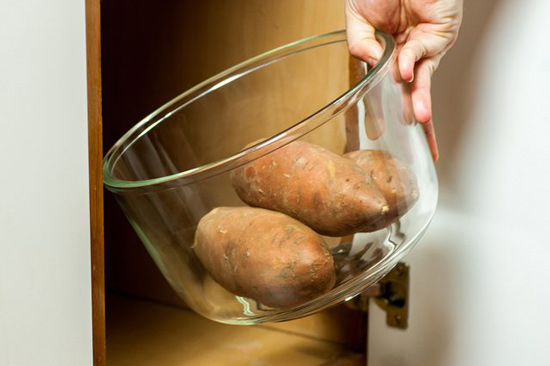
Cucumbers
Where and how to store cucumbers: in a refrigerator.
Terms: 5 days.
Tomatoes
Where and how to store tomatoes: at room temperature, for example, on a tabletop or in a closet.To keep tomatoes in the fridge is impossible - at temperatures below 10 degrees, they lose their flavor and become tasteless. If you need to save the tomatoes for more than three days, then you can put them on the bottom shelf of the refrigerator, and then restore the aroma and taste by holding the fruit at room temperature for about 1 day.
Terms: 3 days - the optimal shelf life for ripe tomatoes.
Tip: in order for unripe tomatoes to ripen, hold them in a paper bag at room temperature (see photo below).
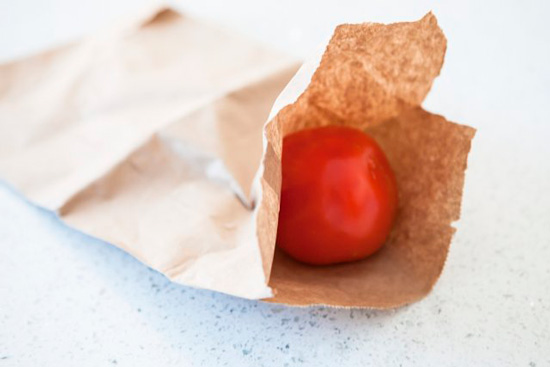
Garlic
Where and how to store garlic: garlic can be stored in a closet or on a worktop, in a storage room or cellar. The main thing is that air is freely circulating around it. Garlic cannot be stored in the refrigerator, since at low temperatures it quickly loses its flavor and taste.
Terms: 2 months.
Bow
Where and how to store onions: Onions can also be stored in a closet or on a worktop, in a closet or cellar. The main thing is that air is freely circulating around it.
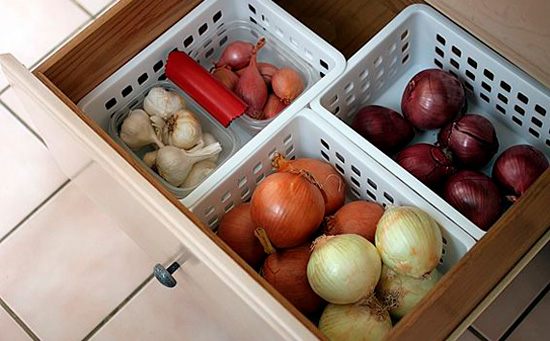
It is best to store onions in mesh bags (in which it is often sold in the store) in order to get this very ventilation. If there is no mesh, then you can fold the bulbs into a bowl and, if desired, cover them with a “breathable” cloth, but not a lid.
It is undesirable to store a whole onion in the refrigerator, but it is better to store sliced onions there and not more than 4 days.
Terms: 2 months.
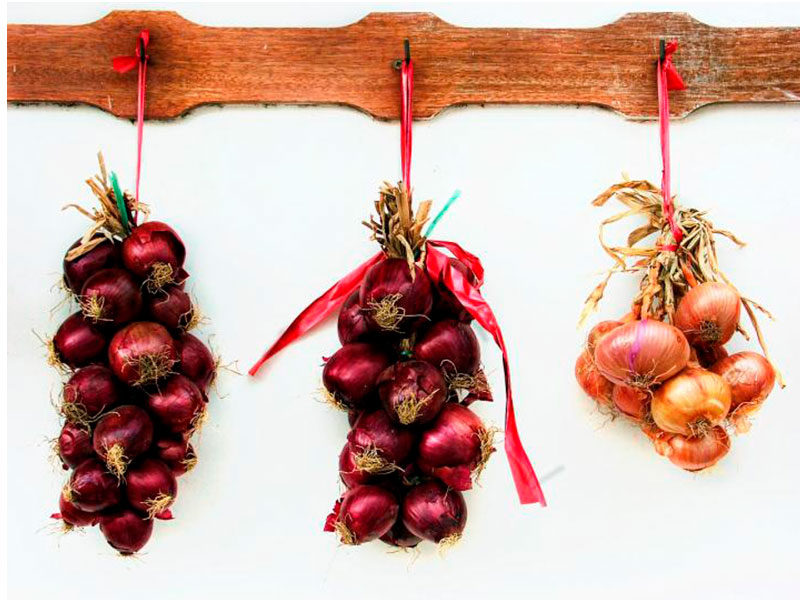
Cabbage (white and red-headed)
Where and how to store cabbage: in the refrigerator, on any shelf.
Terms: 2 weeks.
Brussels sprouts, Savoy and Peking cabbage, cauliflower
Where and how to store: in a refrigerator.
Terms: Week 1.
Carrot
Where and how to store: in a refrigerator.
Terms: 2 weeks.
Sweet pepper
Where and how to store pepper: in the refrigerator, away from the rest of the vegetables.
Terms: 1 week (green pepper); 5 days (red, yellow and orange peppers).
Chili (fresh)
Where and how to store: in a refrigerator.
Terms: 2 weeks.
Note: dried chili peppers will be kept for 4 months in an airtight container.
Broccoli
Where and how to store broccoli: in the refrigerator, on any shelf.
Terms: Week 1.
Beet and its tops
Where and how to store beets: in a refrigerator. Before putting the tops in the refrigerator (by the way, very useful), you need to cut and fold a separate plastic bag.
Terms: 3 weeks, tops - 3 days.
Eggplant
Where and how to store eggplants: in a refrigerator.
Terms: 5 days.
Courgettes, zucchini and pumpkins
Where and how to store zucchini: in a refrigerator, cellar or other dry, dark, and cool place.
Terms: 5 days.
Avocado
Where and how to store avocados: in a refrigerator.
Terms: 3 days.
Tip: in order to ripe ripe avocado, hold it at room temperature in a paper bag until soft.
Artichokes
Where and how to store: in a refrigerator.
Terms: Week 1.
Ginger
Where and how to store ginger: in a refrigerator.
Terms: 3 weeks.
Tip: Ginger can be frozen for up to 6 months. If you want to grate the ginger, you will not have to defrost it.
Mushrooms
Where and how to store mushrooms: in the refrigerator, preferably in a paper bag.
Terms: Week 1.
Turnip
Where and how to store turnips: in a refrigerator.
Terms: 2 weeks.
Tip: Turnip leaves are very useful, so they are often used to make medicinal decoctions. Separate the tops from the root and store it separately in a plastic bag. Leaves will remain fresh for 3 days.
Radish
Where and how to store radishes: in a refrigerator.
Terms: ideally up to 3 days, but maybe 2 weeks.
Tip: remove the leaves from the roots to prolong their freshness.
Asparagus
Where and how to store: in a refrigerator. Before storage, cut off the ends of the asparagus (see photo), then wrap it in a wet towel and fold it into a plastic bag.
Terms: 3 days.
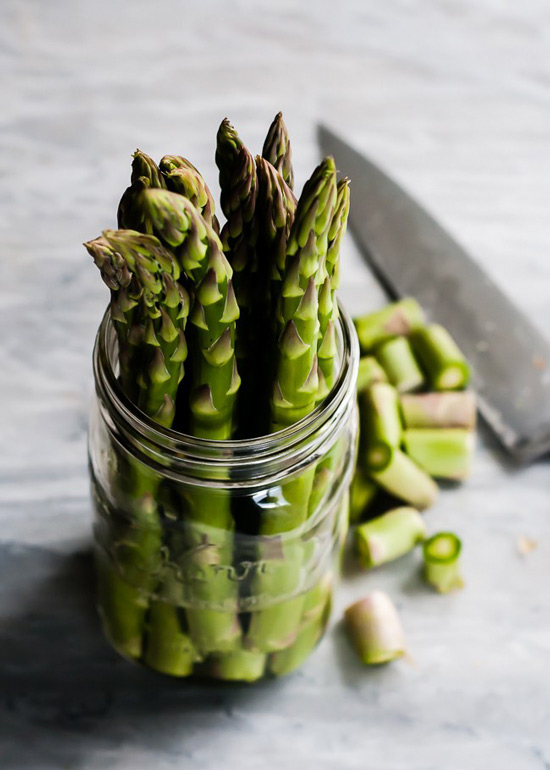
Leek
Where and how to store: in a refrigerator. Before storage, cut off and discard the dark green leek tips, and leave the roots intact (see photo).
Terms: Week 1.
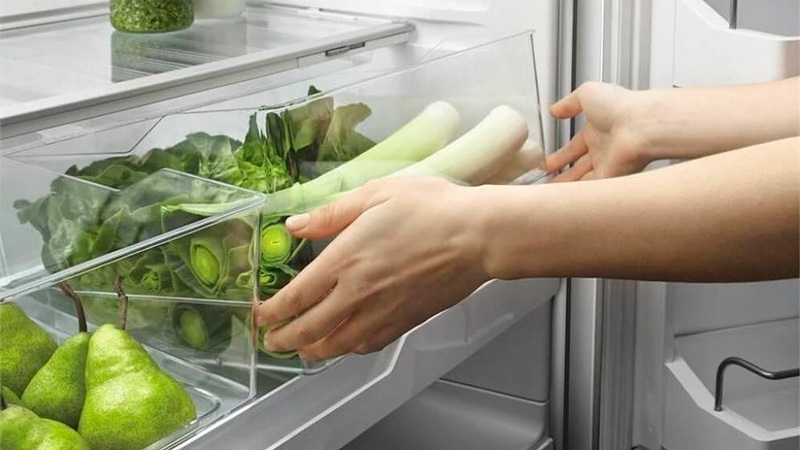
Mustard
Where and how to store: in a refrigerator.
Terms: 3 days.
Okra
Where and how to store: in the refrigerator, in a paper bag.
Terms: 3 days.
Peas, English and Chillies
Where and how to store: in the refrigerator, leaving in the pod until consumed.
Terms: 4 days.
Rhubarb
Where and how to store: in a refrigerator.
Terms: Week 1.
Tip: Rhubarb leaves are not recommended to be eaten in large quantities, as they can be toxic.
Swede
Where and how to store: in the refrigerator or in the closet.
Terms: 1 week - at room temperature, 2 weeks - at low temperature.
Memo for the storage of herbs and herbs
Greens (parsley and dill)
Where and how to store greens: in a refrigerator. Small bunches can be stored in cups of water as bouquets (see photo).
Terms: 5 days.
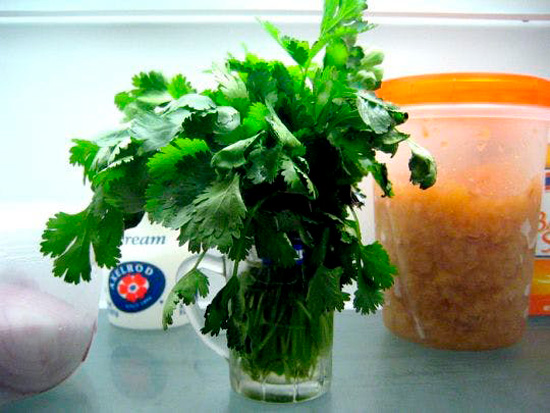
Shallot onions
Where and how to store shallot: can be stored in a closet or on a worktop, in a storage room or cellar. The main thing is that air is freely circulating around it.
Terms: 1 month.
Spinach
Where and how to store: in a refrigerator.
Tip: Regardless of how fresh the leaves look, follow the expiration date printed on the package, as bacteria may develop.
Lettuce salad
Where and how to store: in a refrigerator.
Terms: 5 days.
Tip: Even if the leaves look fresh, follow the expiration date printed on the package.
Watercress
Where and how to store: in a refrigerator.
Terms: 4 days.
Celery
Since celery is porous, it is especially vulnerable to absorb odors from other foods.
Where and how to store: in a refrigerator.
Terms: 2 weeks.
Deciduous herbs (basil, cilantro, scallions, tarragon, parsley, mint)
Where and how to store greens: in a refrigerator.
Terms: 3 days (basil, cilantro, green onions, tarragon); 5 days (parsley, mint).
Tip: Wrap a bunch of greens in a damp paper towel before storing so that it stays fresh longer.
Woody Herbs (Rosemary and Thyme)
Fridge: 2 weeks.
Arugula
Where and how to store: in a refrigerator.
Terms: 5 days.
Radicchio salad
Where and how to store: in a refrigerator.
Terms: 4 days.
Fennel
Where and how to store greens: in a refrigerator.
Terms: 5 days.
And finally, we suggest finding ideas on storing vegetables in the apartment and other useful information in the next video.
- 12 tips on how to keep food fresh longer and stop throwing them out
- Storage Guide 5 types of oils: olive, flaxseed, coconut, sunflower and cream
- 8 questions and answers about storing honey
- Storage in the kitchen - 17 super-efficient solutions and life hacking
- What should be the temperature in the refrigerator?

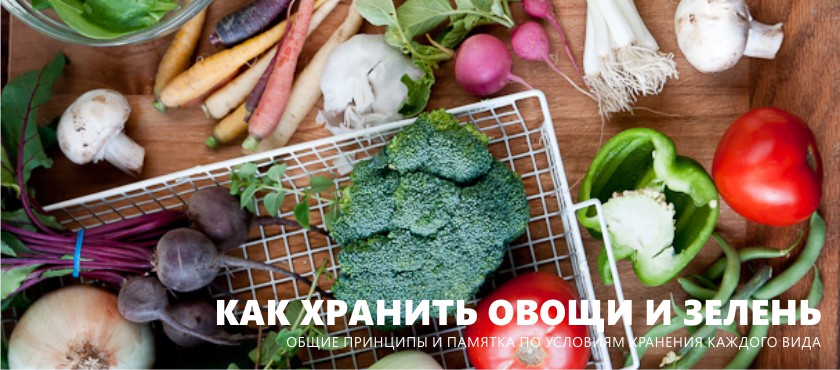

 (Rate the material! Already voted:8 average rating: 4,50 from 5)
(Rate the material! Already voted:8 average rating: 4,50 from 5)
Now there are refrigerators with fresh areas, I have one from a hotpoint, so it’s cool to store greens and vegetables, which are actually fresher for a long time.
my indesite optimal humidity inside the chambers is maintained. thanks to this, vegetables, fruits, and not only, are perfectly stored!
In my Whirlpool there is not only a freshness zone, but also a fresh-box and the option of fast freezing) And even a special shelf for wine))